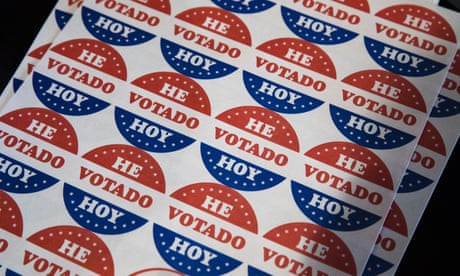- by foxnews
- 04 Apr 2025
How Republicans and Democrats are missing the mark with Latino voters
How Republicans and Democrats are missing the mark with Latino voters
- by theguardian
- 29 Nov 2022
- in politics

In the 2022 midterms, Latino voters reinforced their power as the second-largest voting bloc in the United States.
These voters, who account for nearly 35 million people, or 14%, of the US voting electorate, both tilted the balance for Democrats in key battleground state Senate races in Pennsylvania, Arizona and Nevada and secured a Republican hold in Florida. Since 2018, the number of Latino voters has grown by nearly 5 million people, accounting for more than 60% of newly eligible voters.
Campaigns need to take a page from independent groups, according to Latino political strategists, pollsters and voter mobilization groups. They said political parties need to build trust with voters, listen to what they care about and use that data to tailor culturally relevant messaging to different communities in different states.
That work, however, was on display from independent advocacy groups that supported Democratic candidates, and civic mobilization organizations that focused on galvanizing Latino voters, Rocha said. They invested in showing up in communities, even during off-election years, and built trust over time. He pointed to Nevada, where super Pacs and groups like the Culinary Workers Union and Somos Votantes canvassed neighborhoods across the state and spent millions of dollars in ads that specifically targeted Spanish-speaking voters.
María Teresa Kumar, president and CEO of Voto Latino, says that there is a generational divide: Latino voters are, on average, younger than the rest of the electorate, consisting of people who are newer to the country as immigrants and migrants compared to other voters of color.
And Sanchez found that two-thirds of Latino voters under age 40 supported Democrats compared to 60% of Latino voters over that age. That will play a key role in the upcoming presidential race as campaigns attempt to figure out how to court young voters and make sure they turn out.
Kumar said her group addressed this in the midterm by investing in registration in eight battleground states in 2020, registering 650,000 voters. But she said that campaigns did not invest in the same way because Democratic donors and campaigns internalized the idea that they were losing Latino support to Republicans.
Matt Barreto, a political science professor at UCLA and co-founder of BSP Research, notes that in public opinion polling, Latinos often express shared culture, values, language and customs but politically, they vary depending on the political environment they live in.
The 2022 Midterm Election Voter Poll, which Barreto worked on, found that Latino voters described sharing similar issues of concern: cost of living, gas prices, reproductive rights, healthcare costs and gun violence. But when broken down by Latino voters in states polled, those issues vary depending on the state, with the consensus concern over the economy.
The midterm results offer a roadmap of how parties approached different Latino communities.
In key races in Arizona, Nevada, Colorado, Michigan and Pennsylvania, Latino voter support for Democrats played a significant role. In Arizona, where two-thirds of Latino voters supported Senator Mark Kelly, he capitalized on an already influential long-term investment in Latino voter outreach by grassroots groups to capture wins in Maricopa and Pima counties.
Alvarado, of Somos Votantes, said the group spent $14m on digital, TV and radio ads and voter outreach such as canvassing neighborhoods in support of Democrat Catherine Cortez Masto, the first Latina in Congress who narrowly won re-election.
In Colorado, where the Latino population has grown 72% since 2000, Sanchez worked with the Latino Victory Fund to survey Latino voters about their concerns, particularly in rural areas. That influenced voter outreach efforts and aided in Yadira Caraveo becoming the first Latina to be elected to Congress from the state.
Florida represented an outlier, where Latino voters made a shift toward supporting Republicans, with the largest gains among Cuban and non-Puerto Rican voters, allowing incumbents Governor Ron DeSantis and Senator Marco Rubio to win re-elections by wide margins. But Baretto points out that the strategy remained the same: Long-term investment from Republicans in Florida in English and Spanish ads targeting Latinos since 2020.
That investment strategy among Latino voters could become important in the Georgia runoff between Senator Raphael Warnock and Republican candidate Herschel Walker, where the Latino population is on the rise. While white voters largely supported Walker and Black voters overwhelmingly supported Warnock, Warnock captured 67% of Latino voters, according to exit polling.
Somos Votantes, the national Latino mobilization group that supported Cortez-Masto in Nevada, announced it would invest $2m in the runoff.
- by foxnews
- descember 09, 2016
'I traveled for an entire year for free - and saved $15K'
Hailey Learmonth explored Australia without paying rent, thanks to pet sitting. She saved $15,000, lived on farms, and embraced remote work to travel on a budget.
read more





